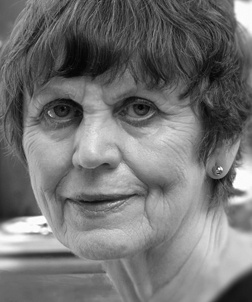MARGARET ANN PETRIE ’60
 “Riveting.” “Exhilarating.” “Inspiring as it is fascinating.” “Enough to charm a cynic.” These are just a handful of reviewers’ kudos for the remarkable film “Mother Teresa” produced by Margaret Ann Petrie ’60 and her sister Jeanette Petrie. The film was shown in 1985 at the opening of the Fortieth Anniversary Celebration of the establishment of United Nations before Mother Teresa addressed the assembly. For Ann, a lot of footage preceded her award-winning film.
“Riveting.” “Exhilarating.” “Inspiring as it is fascinating.” “Enough to charm a cynic.” These are just a handful of reviewers’ kudos for the remarkable film “Mother Teresa” produced by Margaret Ann Petrie ’60 and her sister Jeanette Petrie. The film was shown in 1985 at the opening of the Fortieth Anniversary Celebration of the establishment of United Nations before Mother Teresa addressed the assembly. For Ann, a lot of footage preceded her award-winning film.
Ann fell in love with television production while at Marygrove when a University of Detroit television crew broadcast one of the Drama Society’s plays. After graduation, Ann joined her family in Phoenix and was hired by a CBS-TV affiliate there as a sales secretary. In off hours she haunted the studio to learn everything she could about behind-the-scenes work. Two years later she was hired as a continuity director at ABC-TV New York and then moved up to producer of a public affairs program. According to Gabrielle Baker Burton ’60, Ann was troubled by the lack of positive TV stories, “Ann began to look for subjects that would satisfy this other side of human nature. Before long, she was creating pieces about teachers, health care leaders, and everyday citizens who were making a difference in their own communities.” Gabrielle says that Ann was committed to “making good news interesting.”
Searching for ever-more-interesting material led Ann to Mother Teresa. She thought the coverage of Mother Teresa after she received the Nobel Peace Prize missed her mysterious presence. Ann took a production crew to Calcutta and wrote, produced and directed “The World of Mother Teresa,” a one hour documentary for PBS. Yet Ann was not content that her program told the whole story. The two sisters formed Petrie Productions and sought to make a longer film to show the universality of Mother Teresa’s work with the poorest of the poor. They proved to Mother Teresa that their intent was to tell the truth, by volunteering for two years for one of her causes—caring for the homeless alongside nuns in New York City.
The film, “Mother Teresa,” was the Petrie sisters’ effort to illuminate the human transformations they had seen firsthand in themselves and others. They shot film on-the-run over five years. Credit cards and grants—which often arrived just as they were tapped out– financed them as they followed Mother Teresa through ten countries and over four continents. The result is an intimate look at the unique, hands-on care by Mother Teresa inside war torn Beirut where they sneaked across the border; in Guatemala, where Mother talked the government out of moving the foundation she created for orphans and homeless men and women to a different location; in Calcutta and on the streets of the South Bronx. The film is real rather than sentimental and deliberately avoids heart wrenching clichés of dying children, although they were very much a part of Mother’s charity work.
Mother Teresa, who originally belonged to another congregation, resigned to establish the Missionaries of Charity in the slums of Calcutta. The order has grown from a handful of people to 4,500 sisters in 130 countries. In 1997, Ann and Jan filmed behind-the-scenes of the private burial of Mother Teresa and overlaid footage with Mother Teresa’s own voice. The resulting documentary premiered at the Vatican on the occasion of Mother Teresa’s beatification in 2003.
Ann and Jan have amassed more than 100 hours of film, video and sound and are working to create a digital, interactive, multimedia archive that will make the words and work of Mother Teresa accessible today and for generations to come.
Although Mother Teresa films are the best known of Ann’s work, she earned an Emmy for her television programs at ABC. From 1969 to 1976 she was writer-in-residence and a very highly regarded teacher at the City College of the City University of New York CCNY, during a time of upheaval and profound change at CCNY. She pioneered a new approach to pedagogy and inclusiveness according to colleague Joan Howard. She also worked on movies such as “Moonstruck” and on several other television series.
Ann says, “I have an uncertain, gypsy sort of life. I commute between Toronto and New York and I don’t think I will ever retire. I once thought I would marry and have a lot of children. Instead I had films. However, I have had the privilege of being a sort of ‘aunt’ to the children of cousins and friends, most especially Gabrielle Baker Burton’s five, wonderful daughters.”
